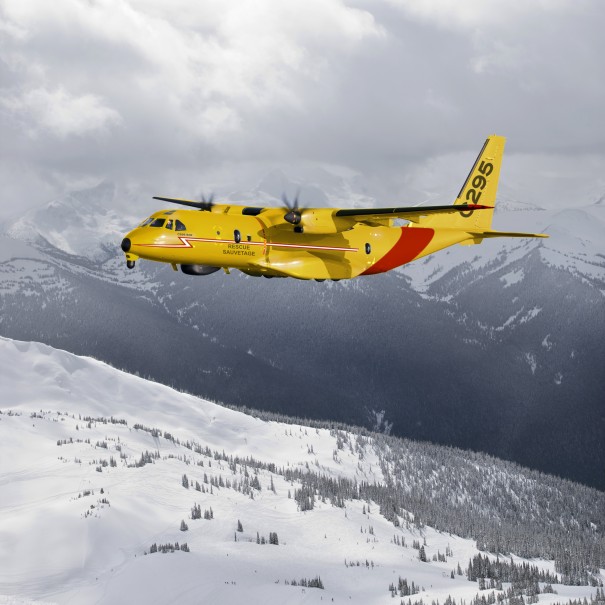Canada has finally reached a decision on a new Fixed Wing Search And Rescue aircraft, choosing the EADS/CASA C295 airframe as the winner of the competition, and the contract. 16 aircraft will be acquired to replace the CC-115 Buffalo and the legacy CC-130 Hercules A/C currently fulfilling this role. The RCAF SAR variant will apparently be closely based on the C295M Maritime Patrol Aircraft (MPA), carrying a surface search radar and an optronic turret. Not known at this time is if the Side-Looking Airborne Radar (SLAR) that is sometimes seen on the MPA variant will be fitted. There is obvious utility to the SLAR radar in the SAR role, that radar could scan a broad swath of terrain looking for evidence of a crash site. A similar SLAR is carried by Canada’s National Aerial Surveillance Program DASH-8’s. There is no reason to not add it to the C295, and good reason to include it.

C295 in near RCAF SAR marking. Picture: EADS/CASA
I, for one, approve of the choice. The C295 does have weaknesses: It is somewhat slower than the C-27J in cruise speed, has a slightly lower range and the cabin is somewhat more cramped side-to-side. What it gains is a cabin length that allows for sensor operators and SAR Techs to not be bumping elbows on a mission. Crew stations are a little more separate, which is not a minor consideration on gruelling SAR missions.
Delivery of the new planes, scheduled to start in 2019 will revitalize RCAF SAR capabilities. There is also significant Canadian content in both the engines (Pratt and Whitney Canada PW127G) and the optronic turret from L-3 Wescam Canada. There is every reason to believe that the plane will be a great asset to Canada.
What of innovation in the Canadian aviation manufacturing sector though? Canada has chosen another foreign aircraft to meet RCAF needs. This obviously doesn’t help the aircraft manufacturing sector to develop new products.
But it can.
The coming retirement of the CC-115 Buffalo will undoubtedly lead many airframes being sent to various bases and museums as “Gate Guardians” or historical displays. One, or possibly two, airframes should be set aside though. Set aside and sent to Viking Aircraft, along with a grant. The size of the grant would be cost sharing in a project that is worthy of investment. Once there, and with grant money in hand, Viking would produce the prototype(s) of the DHC-5NG. The “Next Generation” DHC-5 Buffalo could be prototyped and flown. Canada gains possible future sales and supports our manufacturing sector. This is no minor consideration, a revitalized Buffalo could fill a market niche that has few competitors.
This is how we do innovation, even as we buy from overseas. We leverage the purchase, gain whatever we can as long as it doesn’t mean reducing the original goal of revitalising RCAF SAR capabilities. It isn’t hard, nor is it prohibitively expensive.
Lets do this right. We’ve picked one plane, let’s pick up the chances of another being born.

This has been a very surprising choice as the C295 have not the performance for the FWSAR role? The C295 cargo bay il long, but very narrow. Just a fraction of the C-130 and even of the C-27J. A fully equipped SAR crew cannot move freely insid, nor is possible to equip the interior of the aircraft with all the SAR equipments because the fuselage section is so marrow. The speed and range of the aircraft are not adequate for the mission: much lower than the C-130 and the C-27J Spartan, the C295W competitor in the tender. More: have you investigated the safety statistic of the C295? Have a look at http://www.aviation-safety.net. Saying that it is poor is very politically correct. How the aircraft could operate safely in the harsh Canadian climate is a question mark.
LikeLike
Let’s address your points in order… then drive the stake through the heart of the issue.
The cabin dimensions are comparable to the CC-115 Buffalo, which suggests that the crews will have no issue. Worth noting, cross section is identical to the USCG HC-144 Ocean Sentry, just longer.
The SAR equipment fits easily, with sensor stations forward, SAR Techs aft.
Speed and range are likewise comparable to the CC-115 Buffalo, but on the high side.
There are a total of two hull losses for the C295. Adding C235 losses to distort the comparison is disingenuous. To be fair you would have to add C-27J losses to C-27A AND G.222. Nobody ever seems to do that.
There is no question mark about environmental suitability. None, the aircraft is tested to out operating environment.
And now for the stake.
Italy, and the Italian Air Force do NOT operate any variety of C-27 in the domestic SAR role. That job is taken by the ATR-72. If the country that builds the plane won’t so employ it, Why would we?
And finally:
The cost of the C-27J is such that fewer airframes would be acquired. How does this increase SAR readiness or a availability? It doesn’t. The competition was run on a “capability-driven” model. C295 means 16 airframes, distributed across the country.
Hard for fewer C-27J’s to match that.
LikeLike
[…] Fixed Wing Search & Rescue (FWSAR) Project Col. Ted on FWSAR: “Well done, Team Trudeau, but …” – “FWSAR and Innovation” (DefenceMuse blog) […]
LikeLike